The Radeon HD 5970: Completing AMD's Takeover of the High End GPU Market
by Ryan Smith on November 18, 2009 12:00 AM EST- Posted in
- GPUs

Thanks to AMD’s aggressive power optimizations, the idle power of the 5970 is rated for 42W. In practice this puts it within spitting distance of the 5800 series in Crossfire, and below a number of other cards including the GTX 295, 4870X2, and even the 4870 itself.
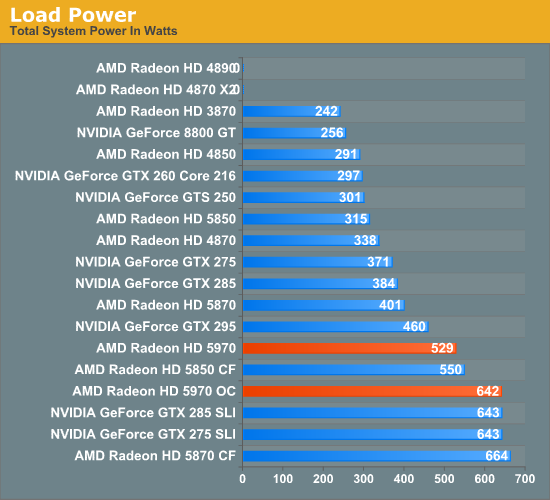
Once we start looking at load power, we find our interesting story. Remember that the 5970 is specifically built and binned in order to meet the 300W cap. As a result it offers 5850CF performance, but at 21W lower power usage, and the gap only increases as you move up the chart with more powerful cards in SLI/CF mode. The converse of this is that it flirts with the cap more than our GTX 295, and as a result comes in 69W higher. But since we’re using OCCT, any driver throttling needs to be taken in to consideration.
Looking at the 5970 when it’s overclocked, it becomes readily apparently why a good power supply is necessary. For that 15% increase in core speed and 20% increase in memory speed, we pay a penalty of 113W! This puts it in league with the GTX series in SLI, and the 5870CF, except that it’s drawing all of this power over half as many plugs. We’re only going to say this one more time: if you’re going to overclock the 5970, you must have a very good power supply.
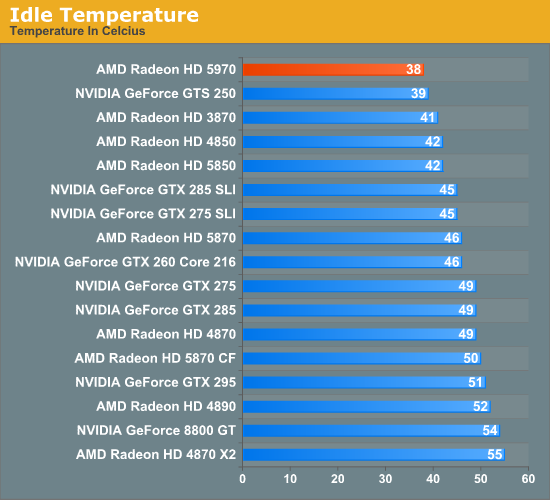
Moving on, the vapor chamber cooler makes itself felt in our temperature testing. The 5970 is the coolest high-end card we’ve tested (yes, you’ve read that right), coming in at 38C, below even the GTS 250. This is in stark opposition to previous dual-GPU cards, which have inhabited the top of the chart. Even the 5850 isn’t quite as cool as a 5970 at idle.
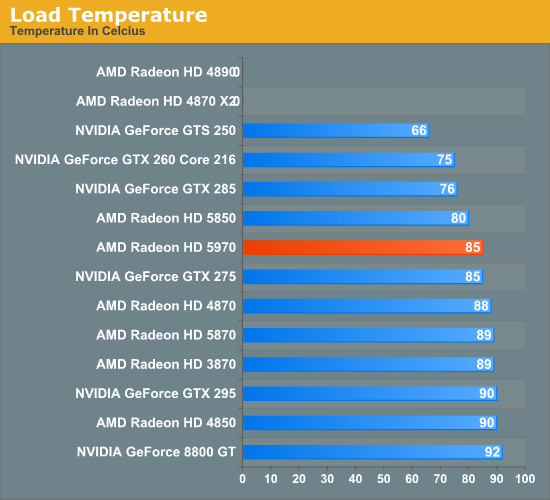
At load, we see a similar but slightly different story. It’s no longer the coolest card, losing out to the likes of the 5850 and GTX 285, but at 85C it hangs with the GTX 275, and below other single and dual-GPU cards such as the 5870 and GTX 295. This is a combination of the vapor cooler, and the fact that AMD slapped an oversized cooler on this card for overclocking purposes. Although Anand’s card failed at OCCT when overclocked, my own card hit 93C here, so assume that this cool advantage erodes under overclocking.
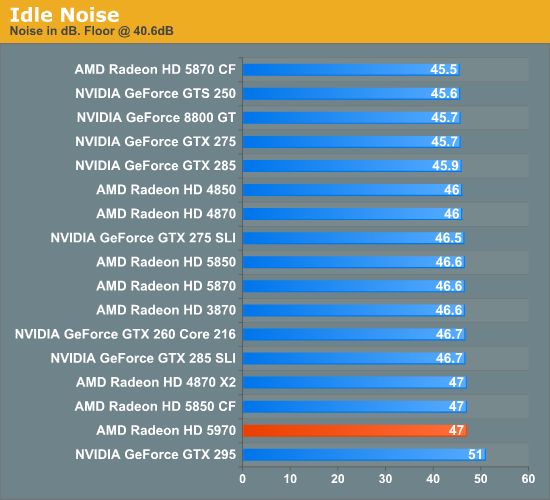
Finally we have our look at noise. Realistically, every card runs up against the noise floor, and the 5970 is no different. At 38C idle, it can keep its fan at very low speeds.
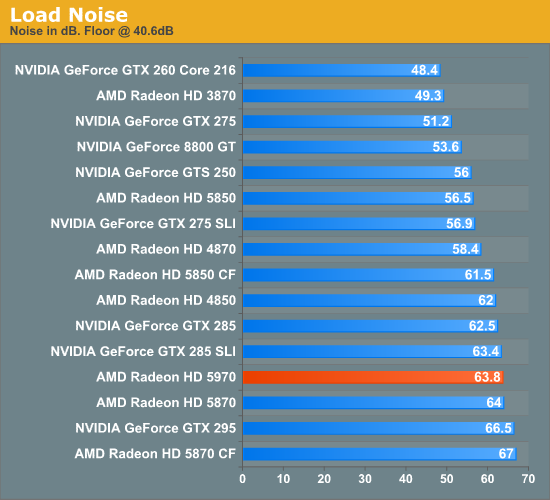
It’s at load that we find another interesting story. At 63.8dB it’s plenty loud, but it’s still quieter than either the GTX 295 or 5870CF, the former of which it is significantly faster than. Given the power numbers we saw earlier, we had been expecting something that registered as louder, so this was a pleasant surprise.
We will add that on a subjective basis, AMD seems to have done something to keep the whine down. The GTX 295 (and 4870X2) aren’t just loud, but they have a slight whine to them – the 5970 does not. This means that it’s not just a bit quieter to sound meters, but it really comes across that way to human ears too. But by the same token, I would consider the 5850CF to quieter still, more so than 2dB would imply.










114 Comments
View All Comments
GourdFreeMan - Friday, November 20, 2009 - link
Having not bought MW2, I can say conversely that the lack of differentiation between console and PC features hurts game sales. According to news reports, in the UK PC sales of MW2 account for less than 3% of all sales. This is neither representative of the PC share of the gaming market (which should be ~25% of all "next-gen" sales based on quarterly reports of revenue from publishers), nor the size of the install base of modern graphics cards capable of running MW2 at a decent frame rate (which should be close to the size of the entire console market based on JPR figures). Admittedly the UK has a proportionately larger console share than the US or Germany, but I can't image MW2 sales of the PC version are much better globally.I am sure executives will be eager to blame piracy for the lack of PC sales, but their target market knows better...
cmdrdredd - Wednesday, November 18, 2009 - link
[quote]Unfortunately, since playing MW2, my question is: are there enough games that are sufficiently superior on the PC to justify the inital expense and power usage of this card? Maybe thats where eyefinity for AMD and PhysX for nVidia come in: they at least differentiate the PC experience from the console.I hate to say it, but to me there just do not seem to be enough games optimized for the PC to justify the price and power usage of this card, that is unless one has money to burn.[/quote]
Yes this is exactly my thoughts. They can tout DX11, fancy schmancy eyefinity, physx, everything except free lunch and it doesn't change the fact that the lineup for PC gaming is bland at best. It sucks, I love gaming on PC but it's pretty much a dead end at this time. No thanks to every 12 year old who curses at you on XBox Live.
The0ne - Wednesday, November 18, 2009 - link
My main reason to want this card would be to drive my 30" LCDs. I have two Dell's already and will get another one early next year. I don't actually play games much but I like having the desktop space for my work.-VM's at higher resolution
-more open windows without switching too much
-watch movie(s) while working
-bigger font size but maintaining the aspect ratio of programs :)
Currently have my main on one 30" and to my 73" TV. TV is only 1080P so space is a bit limited. Plus working on the TV sucks big time :/
shaolin95 - Wednesday, November 18, 2009 - link
I am glad ATI is able to keep competing as that helps keep prices at a "decent" level.Still, for all of you so amazed by eyefinity, do yourselves a favor and try 3D vision with a big screen DLP then you will laugh at what you thought was cool and "3D" before.
You can have 100 monitors but it is still just a flat world....time to join REAL 3D gaming guys!
Carnildo - Wednesday, November 18, 2009 - link
Back in college, I was the administrator for a CAVE system. It's a cube ten feet on a side, with displays on all surfaces. Combine that with head tracking, hand tracking, shutter glasses, and surround sound, and you've got a fully immersive 3D environment.It's designed for 3D visualization of large datasets, but people have ported a number of 3D shooters to the platform. You haven't lived until you've seen a life-sized opponent come around the corner and start blasting away at you.
7Enigma - Wednesday, November 18, 2009 - link
But Ryan, I feel you might need to edit a couple of your comparison comments between the 295 and this new card. Based on the comments in a several previous articles quite a few readers do not look at (or understand) the charts and instead rely on the commentary below the charts. Here's some examples:"Meanwhile the GTX 295 sees the first of many falls here. It falls behind the 5970 by 30%-40%. The 5870 gave it a run for its money, so this is no surprise."
This one for Stalker is clear and concise. I'd recommend you repeat this format for the rest of the games.
"As for the GTX 295, the lead is only 20%. This is one of the better scenarios for the GTX 295."
This comment was for Battleforge and IMO is confusing. To someone not reading the chart it could be viewed as saying the 295 has a 20% advantage. Again I'd stick with your Stalker comment.
"HAWX hasn’t yet reached a CPU ceiling, but it still gets incredibly high numbers. Overclocking the card gets 14% more, and the GTX 295 performance advantage is 26%."
Again, this could be seen as the 295 being 26% faster.
"Meanwhile overclocking the 5970 is good for another 9%, and the GTX 295 gap is 37%."
This one is less confusing as it doesn't mention an advantage but should just mention 37% slower.
Finally I think you made a typo in the conclusion where you said this:
"Overclock your 5970 to 5870 speeds if you can bear the extra power/heat/noise, but don’t expect 5970CF results."
I think you meant 5870CF results...
Overall, though, the article is really interesting as we've finally hit a performance bottleneck that is not so easily overcome (due to power draw and ATX specifications). I'm very pleased, however, that you mention first in the comments that this truly is a card meant for multi-monitor setups only, and even then, may be bottlenecked by design. The 5870 single card setup is almost overkill for a single display, and even then most people are not gaming on >24" monitors.
I've said it for the past 2 generations of cards but we've pretty much maxed out the need for faster cards (for GAMING purposes). Unless we start getting some super-hi res goggles that are reasonably priced, there just isn't much further to go due to display limitations. I mean honestly are those slightly fuzzy shadows worth the crazy perforamnce hit on a FPS? I honestly am having a VERY difficult time seeing a difference in the first set of pictures of the soldier's helmet. The pictures are taken slightly off angle from each other and even then I don't see what the arrow is pointing at. And if I can't see a significant difference in a STILL shot, how the heck am I to see a difference in-game!?
OK enough rant, thanks for the review. :)
Anand Lal Shimpi - Wednesday, November 18, 2009 - link
Thanks for the edits, I've made some corrections for Ryan that will hopefully make the statements more clear.I agree that the need for a faster GPU on the desktop is definitely minimized today. However I do believe in the "if you build it, they will come" philosophy. At some point, the amount of power you can get in a single GPU will be great enough that someone has to take advantage of it. Although we may need more of a paradigm shift to really bring about that sort of change. I wonder if Larrabee's programming model is all we'll need or if there's more necessary...
Take care,
Anand
7Enigma - Wednesday, November 18, 2009 - link
Thank you for the edits and the reply Anand.One of the main things I'd like to see GPU drivers implement is an artificial framerate cap option. These >100fps results in several of the tests at insane resolutions are not only pointless, but add unneccesary heat and stress to the system. Drop back down to normal resolutions that >90% of people have and it becomes even more wasteful to render 150fps.
I always enable V-sync in my games for my LCD (75Hz), but I don't know if this is actually throttling the gpu to not render greater than 75fps. My hunch is in the background it's rendering to its max but only showing on the screen the Hz limitation.
Zool - Wednesday, November 18, 2009 - link
I tryed out full screen furmark with vsync on and off (in 640*480) and the diference was 7 degre celsius. I have a custom cooler on the 4850 and a 20cm side fan on the case so thats quite lot.7Enigma - Thursday, November 19, 2009 - link
Thanks for the reply Zool, I was hoping that was the case. So it seems like if I ensure vsync is on I'm at least limiting the gpu to only displaying the refresh rate of the LCD. Awesome!